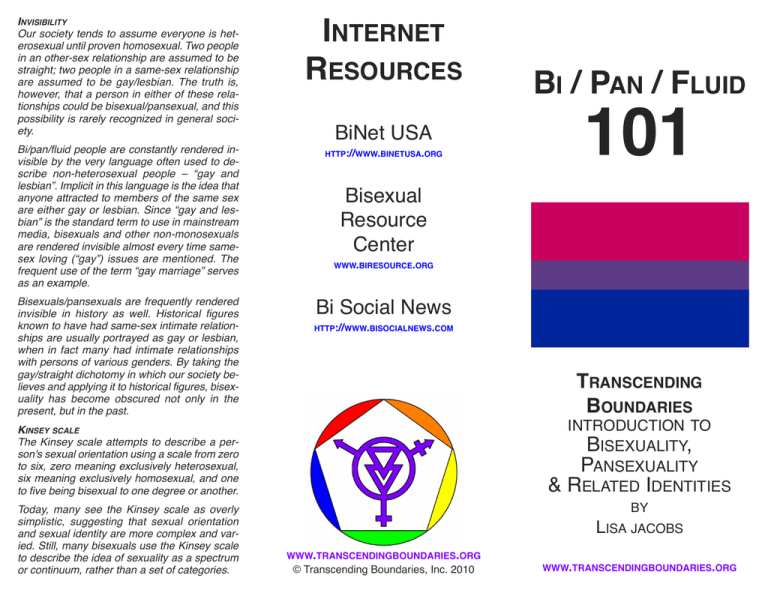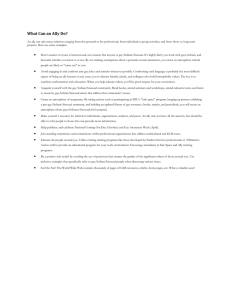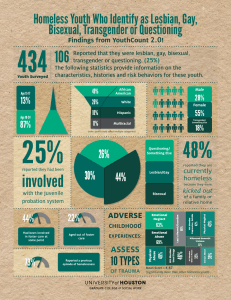
InvIsIbIlIty
Our society tends to assume everyone is heterosexual until proven homosexual. Two people
in an other-sex relationship are assumed to be
straight; two people in a same-sex relationship
are assumed to be gay/lesbian. The truth is,
however, that a person in either of these relationships could be bisexual/pansexual, and this
possibility is rarely recognized in general society.
inTerneT
resources
Bi/pan/fluid people are constantly rendered invisible by the very language often used to describe non-heterosexual people – “gay and
lesbian”. Implicit in this language is the idea that
anyone attracted to members of the same sex
are either gay or lesbian. Since “gay and lesbian” is the standard term to use in mainstream
media, bisexuals and other non-monosexuals
are rendered invisible almost every time samesex loving (“gay”) issues are mentioned. The
frequent use of the term “gay marriage” serves
as an example.
hTTP://www.BineTusa.org
Bisexuals/pansexuals are frequently rendered
invisible in history as well. Historical figures
known to have had same-sex intimate relationships are usually portrayed as gay or lesbian,
when in fact many had intimate relationships
with persons of various genders. By taking the
gay/straight dichotomy in which our society believes and applying it to historical figures, bisexuality has become obscured not only in the
present, but in the past.
Bi social news
101
Binet usa
Bisexual
resource
center
www.Biresource.org
hTTP://www.Bisocialnews.com
Transcending
Boundaries
KInsey scale
The Kinsey scale attempts to describe a person's sexual orientation using a scale from zero
to six, zero meaning exclusively heterosexual,
six meaning exclusively homosexual, and one
to five being bisexual to one degree or another.
Today, many see the Kinsey scale as overly
simplistic, suggesting that sexual orientation
and sexual identity are more complex and varied. Still, many bisexuals use the Kinsey scale
to describe the idea of sexuality as a spectrum
or continuum, rather than a set of categories.
Bi / Pan / Fluid
&
introduction to
Bisexuality,
Pansexuality
related identities
By
lisa jacoBs
www.TranscendingBoundaries.org
© transcending Boundaries, inc. 2010
www.TranscendingBoundaries.org
what is bisexuality/pansexuality?
Bisexuality, pansexuality and other non-monosexual and fluid identities involve the potential
to feel sexually attracted to and to engage in
sensual or sexual relationships with people of
more than one sex or gender. a bi/pan/fluid
person may or may not be equally attracted to
different sexes, or may be attracted to persons
regardless of sex or gender, and the degree of
such attractions may vary over time.
self-perception is the key to a bi/pan/fluid
identity. Many people engage in sexual activity
with people of more than one sex, yet do not
identify as bi/pan/fluid. likewise, other people
engage in sexual relations only with people of
one sex, or do not engage in sexual activity at
all, yet consider themselves bisexual. there is
no behavioral “test” to determine whether or
not one is bisexual, pansexual, or any other
sexual identity.
common myths
m they are confused and can’t make up their mind.
m they are really gay/lesbian and can’t admit it.
m they are really just straight people trying to
be trendy.
m they can’t be monogamous.
m they will always leave someone of the
same sex for a partner of the other sex.
m they are all promiscuous.
m they are just going through a phase.
m they can’t be trusted.
m they give aids to straight women and lesbians.
m they can’t really be ‘queer’.
m they are attracted to anyone and everyone.
m a person has to be equally attracted to
men and women to be bisexual.
m Bi/pan/fluid people are always available.
Most organizations use the word “bisexual” to
refer to all non-monosexual identities, as it is
the most established of all the myriad labels.
the most important thing to remember, however, is to respect each person’s individual
self-identification, however they define it.
examples of biphobia:
m assuming that everyone one meets is either
heterosexual or homosexual.
m supporting and understanding a bi/pan/fluid
identity because you identified "that way"
before you came to your "real"
lesbian/gay/heterosexual identity.
m assuming a bi/pan/fluid person would want
to fulfill one’s sexual fantasies or curiosities.
m using the terms "phase" or "stage" or "confused" or "fence-sitter" or "bisexual" or
"ac/dc" or "switchhitter" as slurs or in an
accusatory way.
what’s the difference between bisexual, pansexual, and other labels?
Good question - it depends who you ask! Bisexual, Pansexual, Fluid, omnisexual, sapiosexual, Multisexual, Queer. some people
claim multiple labels and use them interchangeably. others maintain that bisexuality
refers only to those attracted to both men and
women, whereas pansexuality refers to sexual
attraction regardless of a person’s gender.
“Fluid” is sometimes used to refer to a sexuality that seems to change with time.
felt betrayed by bisexual women who ‘slept
with the enemy’ and didn’t have the courage to
become real lesbians. Many gay men felt that
bisexual men were only out for a good time
and were not really ‘one of them’. although
this attitude has diminished greatly due to the
tireless work of bisexual, pansexual and allied
activists, biphobia amongst gay men and lesbians does still exist. in fact, a good portion of
bi/pan/fluid activism is actually still aimed at
educating the gay and lesbian community.
m not confronting a biphobic remark or joke
for fear of being identified as bisexual.
Biphobia
Biphobia – discrimination against bisexuals,
pansexuals and other non-monosexuals
based on fear and/or misunderstanding – is a
problem specific to bi/pan/fluid people, and exists in both the straight and the gay/lesbian
communities. in the past, many of the most biphobic people have been, in fact, gay or lesbian. Because of this, bisexuals have had to
struggle for the past thirty years to be included
with gays and lesbians in the gay rights movement and the queer community. Many lesbians
m thinking that bi/pan/fluid people will have
their rights when lesbian and gay people
win theirs.
m Being gay or lesbian and asking your bisexual/pansexual friend about their lover only
when that lover is the same sex/gender.
m expecting bi/pan/fluid activists and organizers to minimize their issues and to prioritize
the visibility of "lesbian and/or gay" issues.
m avoiding mentioning to friends that you are
involved with a bisexual/pansexual or working with a bisexual group because you are
afraid they will think you are a bisexual.



